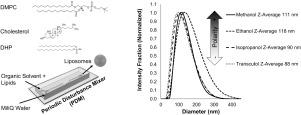Colloids and Surfaces B: Biointerfaces ( IF 5.4 ) Pub Date : 2020-11-04 , DOI: 10.1016/j.colsurfb.2020.111447 Rubén R López 1 , Paula G Font de Rubinat 2 , Luz-María Sánchez 3 , Thupten Tsering 4 , Anas Alazzam 5 , Karl-F Bergeron 6 , Catherine Mounier 6 , Julia V Burnier 4 , Ion Stiharu 7 , Vahé Nerguizian 1

|
Liposomes are versatile particles used in the biomedical field as Drug Delivery Systems (DDS). Liposome production using micromixers have shown to yield nanoparticles for DDS in a single step with a controllable size by changing flow conditions. Nonetheless, other factors such as the organic solvent, play a crucial role in the liposome formation process. Furthermore, drug solubility and toxicity are pivotal when deciding which organic solvent to choose. In this work, liposomes were produced in a Periodic Disturbance Mixer. We investigated three conventional organic solvents: ethanol, methanol, and isopropanol as well as Transcutol®. We assessed the organic solvent influence on liposome characteristics (size, size distribution and zeta potential). Among the four organic solvents, Transcutol® yielded the smallest liposomes, which ranged from 80 nm to 160 nm. Moreover, a more in-depth investigation showed that Transcutol® produced smaller or similar-sized particles under different temperature and lipid concentration conditions, compared with ethanol. Furthermore, we proved that particles zeta potential was not influenced by the organic solvent, production temperature, or lipid concentration. This work results show that Transcutol® could replace the conventional alcohol-based solvents and can potentially avoid filtration steps due to its low toxicity. Therefore, the present approach is appealing in DDS development.
中文翻译:

在周期性干扰混合器中产生的不同有机溶剂对脂质体特性的影响:Transcutol®,潜在的有机溶剂替代品
脂质体是在生物医学领域用作药物输送系统(DDS)的通用颗粒。使用微混合器生产脂质体已显示出可通过改变流动条件,一步控制DDS纳米颗粒的大小。但是,其他因素(例如有机溶剂)在脂质体形成过程中起着至关重要的作用。此外,在决定选择哪种有机溶剂时,药物溶解度和毒性至关重要。在这项工作中,脂质体是在周期性扰动混合器中生产的。我们研究了三种常规有机溶剂:乙醇,甲醇和异丙醇以及Transcutol®。我们评估了有机溶剂对脂质体特征(大小,大小分布和ζ电势)的影响。在四种有机溶剂中,Transcutol®产生的脂质体最小,范围从80 nm到160 nm。此外,更深入的研究表明,与乙醇相比,Transcutol®在不同的温度和脂质浓度条件下会产生较小或相似大小的颗粒。此外,我们证明了粒子的ζ电位不受有机溶剂,生产温度或脂质浓度的影响。这项工作结果表明,Transcutol®可以替代传统的醇基溶剂,并且由于其低毒性而可以避免过滤步骤。因此,本方法在DDS开发中很有吸引力。我们证明了粒子的ζ电位不受有机溶剂,生产温度或脂质浓度的影响。这项工作结果表明,Transcutol®可以替代传统的醇基溶剂,并且由于其低毒性而可以避免过滤步骤。因此,本方法在DDS开发中很有吸引力。我们证明了粒子的ζ电位不受有机溶剂,生产温度或脂质浓度的影响。这项工作结果表明,Transcutol®可以替代传统的醇基溶剂,并且由于其低毒性而可以避免过滤步骤。因此,本方法在DDS开发中很有吸引力。











































 京公网安备 11010802027423号
京公网安备 11010802027423号